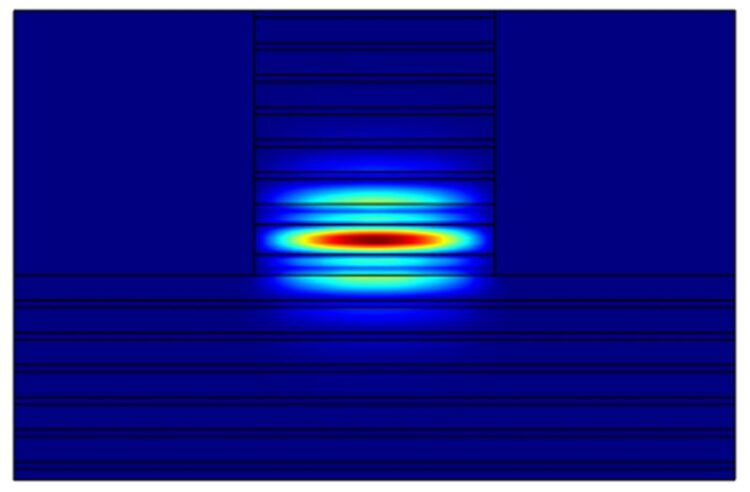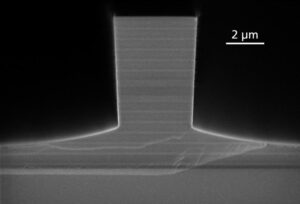Compact on-chip photon pair sources for quantum technologies

Simuliertes Profil einer Bragg-Reflexions-Lichtwellenmode in einem AlGaAs-Bragg-Reflexions-Rippenwellenleiter.
Fraunhofer IAF
Fraunhofer IAF starts a project on compact on-chip sources for entangled photons, which are an important component for the realization of industrial quantum technology applications. In the project “QuoAlA”, scientists are researching waveguides based on aluminum gallium arsenide (AlGaAs) as sources for generating entangled photons. AlGaAs enables a particularly compact design and chip integration. The project started in February and is funded by the BMBF within the funding program “Quantum technologies—from basic research to market” as “WiVoPro” (Scientific Preliminary Project).

Fraunhofer IAF
Quantum technological applications are based on various quantum phenomena and physical laws to which elementary particles are subjected. These include the effect of entangled photons, on which promising concepts for high-precision sensor technology and secure quantum communication are based. In order to bring these technologies into application, compact and efficient sources of entangled photon pairs are needed that can be integrated into photonic circuits.
The main components of quantum photonic systems, such as mirrors, beam splitter and phase shifters, can all be realized in integrated form by now. However, this does not yet apply to the light sources and detectors that are required as well. “Our goal is now to integrate all the functions needed for quantum communication, i.e. the generation, manipulation and detection of single and entangled photons, into just one chip,” explains Dr. Thorsten Passow, project manager at the Fraunhofer Institute for Applied Solid State Physics IAF. The researchers are taking a first step with regard to light sources with the project “Quantum entangled photon pair source at telecom wavelength based on AlGaAs Bragg reflection waveguides (QuoAlA)”.
AlGaAs Bragg reflection waveguides as photon pair sources
The focus of “QuoAlA” is on fundamental research of AlGaAs-based photon sources and their epitaxial fabrication. The aim is to generate photon pairs with a high quality of entanglement at an exactly defined wavelength. The target wavelength is 1550 nm, which is within the telecom range (1500-1600 nm).
The semiconductor material AlGaAs is a promising material for photon pair sources for several reasons. For example, it has nonlinear properties. In a material with nonlinear properties, a photon can spontaneously split into two photons at high light intensity due to an optical effect. Such light particle pairs can be quantum mechanically entangled.
Potential for particularly compact design
Furthermore, AlGaAs Bragg reflection waveguides allow the integration of other optical and electronic components on chip level. “A unique feature of the technology used in the project “QuoAlA” is the potential to integrate a pump laser diode. This makes a particularly compact design possible,” emphasizes Dr. Passow. By reducing the size, weight and power of the components, an essential requirement for the realization of practical applications would be met.
For use as a source in telecommunications, it must be possible to adjust the wavelength of the photons very precisely because the wavelength spacing of the channels is less than 1 nm. The wavelength of the generated photons depends very sensitively on the epitaxial produced layer structure of the waveguides. Therefore, the project focuses on the accuracy of the epitaxy of AlGaAs-based Bragg reflection waveguides with regard to the wavelength of the generated entangled photons.
The AlGaAs waveguide structures in the project benefit from the decades of experience of Fraunhofer IAF in the epitaxy of high-quality GaAs-based heterostructures as well as in process technology for the realization of waveguide structures in various III-V semiconductor materials. In addition, the scientists are using software for the optical simulation of Bragg reflection waveguides that they previously developed in the project “NESSiE”.
The project “QuoAlA” is funded by the Federal Ministry of Education and Research within the framework program of the Federal Government “Quantum technologies—from basic research to market” as “WiVoPro” (Scientific Preliminary Project) (FKZ: 13N15480). The aim of these preliminary projects is to study scientific issues with regard to future industrial applications in photonics and quantum technology. They are intended to complement existing research funding and build a bridge between basic research and industry-led collaborative funding.
About Fraunhofer IAF
The Fraunhofer Institute for Applied Solid State Physics IAF is one of the world’s leading research institutions in the fields of III-V semiconductors and synthetic diamond. Based on these materials, Fraunhofer IAF develops components for future-oriented technologies, such as electronic circuits for innovative communication and mobility solutions, laser systems for real-time spectroscopy, novel hardware components for quantum computing as well as quantum sensors for industrial applications.
With its research and development, the Freiburg research institute covers the entire value chain – from materials research, design and processing to modules, systems and demonstrators.
www.iaf.fraunhofer.de/en
This press release is available on the Internet at:
https://www.iaf.fraunhofer.de/en/media-library/press-releases/on-chip-photon-pai…
Weitere Informationen:
https://www.iaf.fraunhofer.de/en/researchers/optoelectronic-devices/quoala.html
Media Contact
All latest news from the category: Physics and Astronomy
This area deals with the fundamental laws and building blocks of nature and how they interact, the properties and the behavior of matter, and research into space and time and their structures.
innovations-report provides in-depth reports and articles on subjects such as astrophysics, laser technologies, nuclear, quantum, particle and solid-state physics, nanotechnologies, planetary research and findings (Mars, Venus) and developments related to the Hubble Telescope.
Newest articles
Faster, more energy-efficient way to manufacture an industrially important chemical
Zirconium combined with silicon nitride enhances the conversion of propane — present in natural gas — needed to create in-demand plastic, polypropylene. Polypropylene is a common type of plastic found…

Energy planning in Ghana as a role model for the world
Improving the resilience of energy systems in the Global South. What criteria should we use to better plan for resilient energy systems? How do socio-economic, technical and climate change related…

Artificial blood vessels could improve heart bypass outcomes
Artificial blood vessels could improve heart bypass outcomes. 3D-printed blood vessels, which closely mimic the properties of human veins, could transform the treatment of cardiovascular diseases. Strong, flexible, gel-like tubes…





















